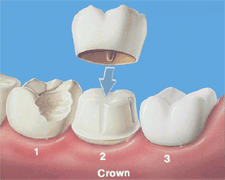المقالات
Failing Crown

Even though a crown protects and strengthens your tooth, you can still develop a cavity at the crown's edge, where it meets the tooth. This area is very prone to developing plaque, and it can be one of the toughest spots in your mouth to keep plaque-free.
If the decay has barely started next to a crown, it's easy to fix with a filling, unless it's between your teeth where we just can't get to it. If the cavity penetrates the protective outer enamel layer and reaches the softer dentin layer, it progresses much more quickly and can cause an infection in the inner pulp layer containing your tooth's nerves and blood vessels.
When your tooth's pulp is infected, the only way to treat the infection is by performing root canal treatment to remove the infected tissue. Without root canal treatment, the infection will continue to spread; pus from the infection may gather at the tip of the root and pass into the jaw bone, causing an abscess. An abscess can be excruciatingly painful, and can damage the bone that surrounds your tooth.
For these reasons, if your crown has failed, we typically recommend removing it and the decay beneath it. We'll then replace the old crown with a new one, which will re-seal your tooth and protect it from further decay and infection.
By replacing the crown early, before the decay gets into the pulp chamber of your tooth, you can avoid discomfort, unnecessary damage to your tooth and more complicated, extensive treatment.
